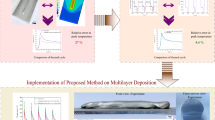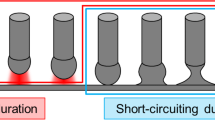Abstract
There is a high demand for increased efficiency and quality in welding, especially for gas metal arc welding, which has wide industrial applications. Moreover, the independent control of the heat input and the deposition rate is also important for some applications such as dissimilar material welding and the wire arc additive manufacturing process which needs low heat input despite a higher deposition rate. A controlled short-circuit transfer process is expected to be a high-quality and high-productivity process. In this process, short-circuit transfer is stably and periodically repeated to enable the low heat input and high deposition rate, and the independent control of the heat input and the deposition rate was achieved to a certain extent. However, control factors for the heat input and the deposition rate in this process are not clear enough because of the lack of investigations for the process. In this study, we have explored the welding phenomena of a controlled short-circuit transfer process by developing an arc-electrode unified model. In this model, short-circuit transfer process was conducted, including the extinction and the reignition of the arc plasma, and the dynamic behavior of the arc and the molten metal was observed. The results observed were in good agreement with the experimental measurements. Furthermore, we also determined the control factors for the heat input to electrodes.












Similar content being viewed by others
References
Pickin CG, Young K (2006) Evaluation of cold metal transfer (CMT) process for welding aluminium alloy. Sci Technol Weld Join 11:583–585. https://doi.org/10.1179/174329306X120886
Fan HG, Kovacevic R (2004) A unified model of transport phenomena in gas metal arc welding including electrode, arc plasma and molten pool. J Phys D Appl Phys 37:2531–2544. https://doi.org/10.1088/0022-3727/37/18/009
Murphy AB (2013) Influence of metal vapour on arc temperatures in gas–metal arc welding: convection versus radiation. J Phys D Appl Phys 46:224004. https://doi.org/10.1088/0022-3727/46/22/224004
Ogino Y, Hirata Y (2016) A unified numerical model of MIG welding process. Q J Jpn Weld Soc 34:35–41. (in Japanese). https://doi.org/10.2207/qjjws.34.35
Murphy AB (2010) The effects of metal vapour in arc welding. J Phys D Appl Phys 43:434001. https://doi.org/10.1088/0022-3727/43/43/434001
Cram LE (1985) Statistical evaluation of radiative power losses from thermal plasmas due to spectral lines. J Phys D Appl Phys 18:401–411. https://doi.org/10.1088/0022-3727/18/3/009
Sansonnens L, Haidar J, Lowke JJ (2000) Prediction of properties of free burning arcs including effects of ambipolar diffusion. J Phys D Appl Phys 33:148–157. https://doi.org/10.1088/0022-3727/33/2/309
Amsden AA, Harlow FH (1970) The SMAC method: a numerical technique for calculating incompressible fluid flows. Los Alamos Scientific Laboratory LA-4370, New Mexico
Hirt CW, Nichols BD (1981) Volume of fluid (VOF) method for the dynamics of free boundaries. J Comput Phys 39:201–225. https://doi.org/10.1016/0021-9991(81)90145-5
Brackbill JU, Kothe DB, Zemach C (1991) A continuum method for modeling surface tension. J Comput Phys 100:335–354. https://doi.org/10.1016/0021-9991(92)90240-Y
Albadawi A, Donoghue DB, Robinson AJ, Murray DB, Delauré YMC (2013) Influence of surface tension implementation in volume of fluid and coupled volume of fluid with level set methods for bubble growth and detachment. Int J Multiphase Flow 53:11–28. https://doi.org/10.1016/j.ijmultiphaseflow.2013.01.005
Menart J, Malik S (2002) Net emission coefficients for argon-iron thermal plasmas. J Phys D Appl Phys 35:867–874. https://doi.org/10.1088/0022-3727/35/9/306
Wilke CR (1950) A viscosity equation for gas mixtures. J Chem Phys 18:517–519. https://doi.org/10.1063/1.1747673
Murphy AB (1996) A comparison of treatments of diffusion in thermal plasmas. J Phys D Appl Phys 29:1922–1932. https://doi.org/10.1088/0022-3727/29/7/029
Author information
Authors and Affiliations
Corresponding author
Additional information
Publisher’s note
Springer Nature remains neutral with regard to jurisdictional claims in published maps and institutional affiliations.
Recommended for Publikation by Study Group 212 - The Physics of Welding
Rights and permissions
About this article
Cite this article
Eda, S., Ogino, Y. & Asai, S. Numerical simulation of dynamic behavior in controlled short-circuit transfer process. Weld World 64, 353–364 (2020). https://doi.org/10.1007/s40194-019-00837-7
Received:
Accepted:
Published:
Issue Date:
DOI: https://doi.org/10.1007/s40194-019-00837-7




